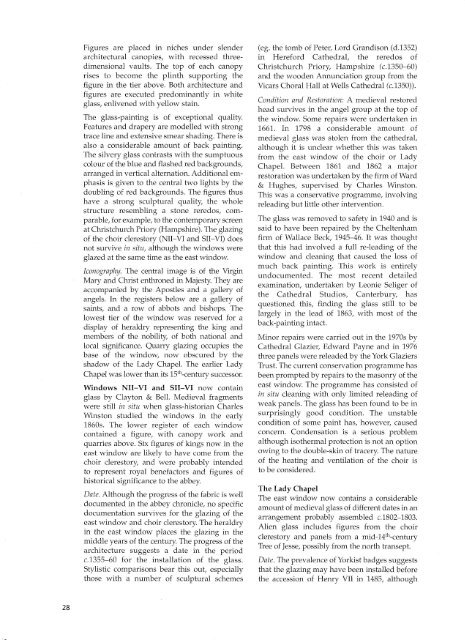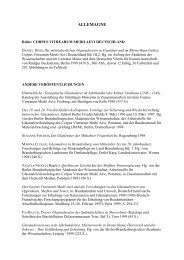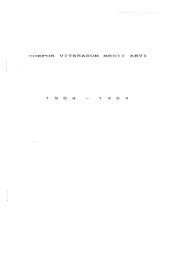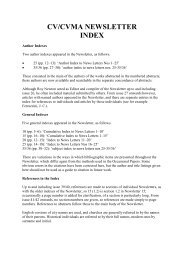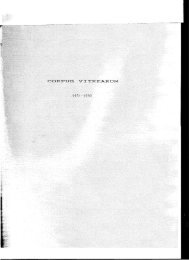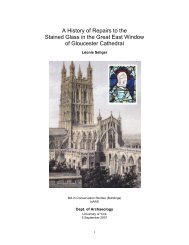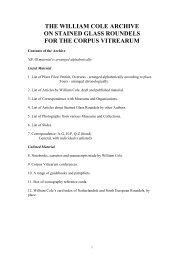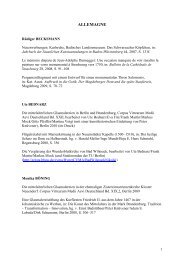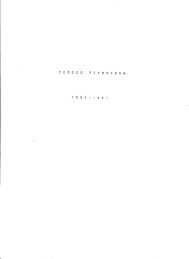BristolConference - Corpus Vitrearum Medii Aevi
BristolConference - Corpus Vitrearum Medii Aevi
BristolConference - Corpus Vitrearum Medii Aevi
Create successful ePaper yourself
Turn your PDF publications into a flip-book with our unique Google optimized e-Paper software.
Figures are placed in niches under slender<br />
architectural canopies, with recessed threedimensional<br />
vaults. The top of each canopy<br />
rises to become the plinth supporting the<br />
figure in the tier above. Both architecture and<br />
figures are executed predominantly in white<br />
glass, enlivened with yellow stain.<br />
The glass-painting is of exceptional quality.<br />
Features and drapery are modelled with strong<br />
trace line and extensive smear shading. There is<br />
also a considerable amount of back painting.<br />
The silvery glass contrasts with the sumptuous<br />
colour of the blue and flashed red backgrounds,<br />
arranged in vertical alternation. Additional emphasis<br />
is given to the central two lights by the<br />
doubling of red backgrounds. The figures thus<br />
have a strong sculptural quality, the whole<br />
structure resembling a stone reredos, comparable,<br />
for example, to the contemporary screen<br />
at Christchurch Priory (Hampshire). The glazing<br />
of the choir clerestory (NIl-VI and SII-VI) does<br />
not survive in situ, although the windows were<br />
glazed at the same time as the east window.<br />
Iconography. The central image is of the Virgin<br />
Mary and Christ enthroned in Majesty. They are<br />
accompanied by the Apostles and a gallery of<br />
angels. In the registers below are a gallery of<br />
saints, and a row of abbots and bishops. The<br />
lowest tier of the window was reserved for a<br />
display of heraldry representing the king and<br />
members of the nobility, of both national and<br />
local significance. Quarry glazing occupies the<br />
base of the window, now obscured by the<br />
shadow of the Lady Chapel. The earlier Lady<br />
Chapel was lower than its 15 th -century successor.<br />
Windows NIl-VI and SII-VI now contain<br />
glass by Clayton & Bell. Medieval fragments<br />
were still in situ when glass-historian Charles<br />
Wins ton studied the windows in the early<br />
1860s. The lower register of each window<br />
contained a figure, with canopy work and<br />
quarries above. Six figures of kings now in the<br />
east window are likely to have come from the<br />
choir clerestory, and were probably intended<br />
to represent royal benefactors and figures of<br />
historical significance to the abbey.<br />
Date. Although the progress of the fabric is well<br />
documented in the abbey chronicle, no specific<br />
documentation survives for the glazing of the<br />
east window and choir clerestory. The heraldry<br />
in the east window places the glazing in the<br />
middle years of the century. The progress of the<br />
architecture suggests a date in the period<br />
c.1355-60 for the installation of the glass.<br />
Stylistic comparisons bear this out, especially<br />
those with a number of sculptural schemes<br />
(eg. the tomb of Peter, Lord Grandison (d.1352)<br />
in Hereford Cathedral, the reredos of<br />
Christchurch Priory, Hampshire (c.1350-60)<br />
and the wooden Annunciation group from the<br />
Vicars Choral Hall at Wells Cathedral (c.1350)).<br />
Condition and Restoration: A medieval restored<br />
head survives in the angel group at the top of<br />
the window. Some repairs were undertaken in<br />
1661. In 1798 a considerable amount of<br />
medieval glass was stolen from the cathedral,<br />
although it is unclear whether this was taken<br />
from the east window of the choir or Lady<br />
Chapel. Between 1861 and 1862 a major<br />
restoration was undertaken by the firm of Ward<br />
& Hughes, supervised by Charles Winston.<br />
This was a conservative programme, involving<br />
releading but little other intervention.<br />
The glass was removed to safety in 1940 and is<br />
said to have been repaired by the Cheltenham<br />
firm of Wallace Beck, 1945-46. It was thought<br />
that this had involved a full re-leading of the<br />
window and cleaning that caused the loss of<br />
much back painting. This work is entirely<br />
undocumented. The most recent detailed<br />
examination, undertaken by Leonie Seliger of<br />
the Cathedral Studios, Canterbury, has<br />
questioned this, finding the glass still to be<br />
largely in the lead of 1863, with most of the<br />
back-painting intact.<br />
Minor repairs were carried out in the 1970s by<br />
Cathedral Glazier, Edward Payne and in 1976<br />
three panels were releaded by the York Glaziers<br />
Trust. The current conservation programme has<br />
been prompted by repairs to the masonry of the<br />
east window. The programme has consisted of<br />
in situ cleaning with only limited releading of<br />
weak panels. The glass has been found to be in<br />
surprisingly good condition. The unstable<br />
condition of some paint has, however, caused<br />
concern. Condensation is a serious problem<br />
although isothermal protection is not an option<br />
owing to the double-skin of tracery. The nature<br />
of the heating and ventilation of the choir is<br />
to be considered.<br />
The Lady Chapel<br />
The east window now contains a considerable<br />
amount of medieval glass of different dates in an<br />
arrangement probably assembled c.1802-1803.<br />
Alien glass includes figures from the choir<br />
clerestory and panels from a mid-Id'l'-century<br />
Tree of Jesse, possibly from the north transept.<br />
Date. The prevalence of Yorkist badges suggests<br />
that the glazing may have been installed before<br />
the accession of Henry VII in 1485, although<br />
28


